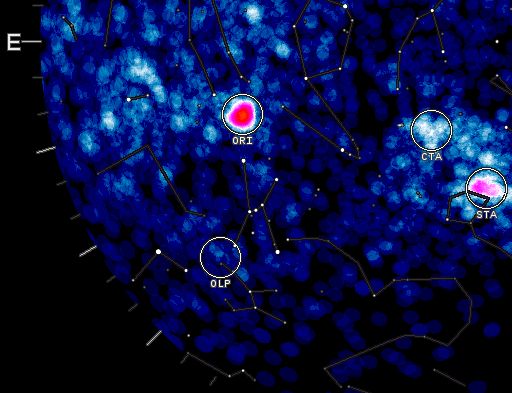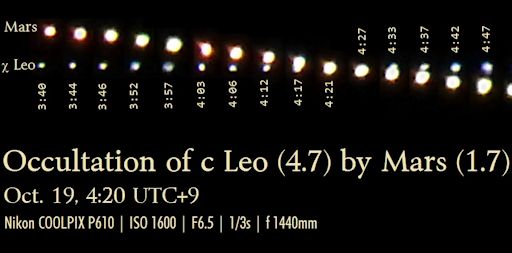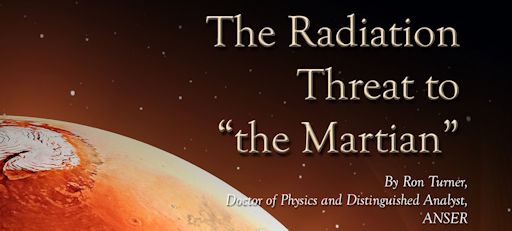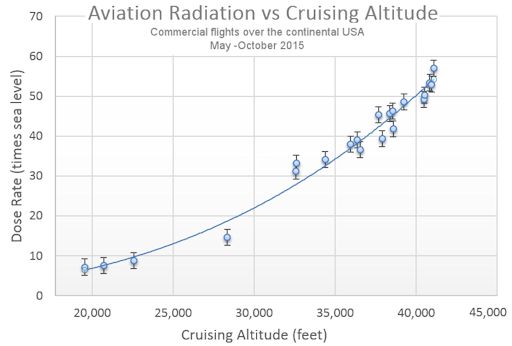Marianne's Heaven On Earth Aurora Chaser Tours Chasethelighttours.co.uk invites you to join them in their quest to find and photograph the Aurora Borealis. Experience the winter wonderland in the Tromsø Area. | | |
MINOR STORM WARNING: High-latitude sky watchers should be alert for auroras after nightfall on Wednesday. Earth is about to enter a fast-moving stream of solar wind, and this could spark minor (G1-class) geomagnetic storms on Oct. 21st. Aurora alerts: text or voice
METEORS FROM HALLEY'S COMET--TONIGHT! Earth is passing through a stream of debris from Halley's Comet, source of the annual Orionid meteor shower. Forecasters expect the shower to peak on Oct. 20-21 with as many as 20 meteors per hour. The best time to look is during the dark hours before sunrise on Wednesday the 21st: sky map.
As the shower intensifies on Oct. 20th, the Canadian Meteor Orbit Radar (CMOR) near Tavistock, Ontario, is picking up echoes from the constellation Orion. The bright pink "hot spot" in this radar sky map shows where bits of Halley's Comet are distintegrating approximately 100 km above Earth's surface:

This radar activity raises the possibility that you can experience the Orionids without even going outside. Just listen to their echoes on Space Weather Radio.
Realtime Meteor Photo Gallery
MARS ECLIPSES A STAR: Astrophotographer "Shiraishi" of Japan woke up before sunrise on Monday morning to watch the ongoing convergence of Mars, Jupiter and Venus. As he watched, Mars did something unusual. "The Red Planet eclipsed a star," says Shiraishi, who documented the event with this sequence of images:

"This is a rare occultation in which a planet passed in front of a bright star visible to the naked eye," says Shiraishi. "It could be seen from the coasts of the Pacific Ocean, including Japan." He also made a movie of the event.
The eclipse is over, but the morning planet show continues. Mars, Jupiter and Venus are gathering for a six-day close encounter stretching from Oct. 24th to Oct. 29th. On those dates the three planets will fit within a circle only 5o wide (sky maps: #1, #2, #3, #4, #5, #6). Typical binoculars can see a patch of sky about 6o or 7o wide. So when the triangle of planets shrinks to 5o, they will fit together inside a binocular field of view. Imagine looking through the eyepiece and seeing three planets--all at once.
By the time October comes to an end, the planetary triangle will start breaking apart. But there are still two dates of special interest: Nov. 6th and 7th (sky maps: #1, #2). On those increasingly wintry mornings, the crescent Moon will swoop in among the dispersing planets for a loose but beautiful conjunction.
Realtime Space Weather Photo Gallery
DID RADIATION KILL THE MARTIAN? Spoiler alert: Stop reading now if you haven't yet seen The Martian. Also, a sharable permalink to this article may be found here.
The #1 movie in theatres right now is The Martian, a film adaptation of Andy Weir's eponymous book. It tells the heart-pounding story of fictional astronaut Mark Watney, who is stranded on Mars and ultimately rescued by the crewmates who had inadvertently left him behind. To survive long enough to be rescued, Watney has to "science the hell out of" a very tricky situation: he grows food in alien soil, extracts water from rocket fuel, dodges Martian dust storms, and sends signals to NASA using an old Mars rover that had been buried in red sand for some 30 years.
It's a thrilling adventure told with considerable accuracy—except, perhaps, for one thing. "While Andy Weir does a good job of representing the risks faced by Mark Watney stranded on Mars, he is silent on the threat of radiation, not just to Mark but particularly to the crew of the Hermes as they execute a daring rescue mission that more than doubles their time in deep space," says Dr. Ron Turner, Distinguished Analyst at ANSER, a public-service research institute in Virginia.

Space radiation comes from two main sources: solar storms and galactic cosmic rays. Solar storms are intense, short-lived, and infrequent. Fortunately for Mark, there weren't any during his mission. He dodged that bullet. However, he and his crewmates could not have avoided cosmic rays. These are high-energy particles that arise from supernovas, colliding neutron stars, and other violent events happening all the time in the Milky Way. They are ever-present, 24/7, and there is no way to avoid them. So far, NASA has developed no effective shield against these sub-atomic cannon balls from deep space. "Doubling a nominal spacecraft shielding thickness only reduces the GCR [galactic cosmic rays] exposure by a few percent," notes Turner.
In the movie, Watney is actually safer than the crew of the Hermes. Turner explains: "The radiation exposure is significantly less on the surface of Mars. For one thing, the planet beneath your feet reduces your exposure by half. The atmosphere, while thin, further reduces the dose. The dose rate on Mars, while high, is only about 1/3rd of that on the Hermes."
The biggest threat from cosmic radiation exposure is the possibility of dying from radiation-induced cancer sometime after a safe return to Earth. NASA's radiation limits today are set to limit this life-shortening risk to less than three percent. Taking into account many factors, such as the phase of the solar cycle and the number of days the crew spent in deep space and on the surface of Mars, Turner has calculated the total dose of cosmic rays absorbed by Watney (41 cSv) and the crew (72 cSv). "cSV" is a centi-Seivert, a unit of radiation commonly used in discussion of human dose rates.
There is considerable uncertainty in how these doses translate into an increased risk of cancer. Turner estimates the added risk to Watney as somewhere between 0.25% and 3.25%. For members of the crew, the added risk ranges from 0.48% to 7.6%. The high end of these ranges are well outside NASA safety limits. The crew especially could be facing medical problems after their homecoming.
Post-flight cancer is not the only problem, however. "There is some additional concern that sustained radiation exposure could lead to other problems that manifest during the mission, instead of years afterward. Possible examples include heart disease, reduced immune system effectiveness, and neurological effects mimicking the symptoms of Alzheimer disease."
As far as we can tell, none of these things happened to the crew of the Hermes. It's just as well. They had enough trouble without cosmic rays.
Sharable permalink: Did Radiation Kill the Martian?
Realtime Aurora Photo Gallery
Realtime Eclipse Photo Gallery
Realtime Sprite Photo Gallery
Every night, a network of
NASA all-sky cameras scans the skies above the United States for meteoritic fireballs. Automated software maintained by NASA's Meteoroid Environment Office calculates their orbits, velocity, penetration depth in Earth's atmosphere and many other characteristics. Daily results are presented here on Spaceweather.com.
On Oct. 20, 2015, the network reported 56 fireballs.
(36 sporadics, 18 Orionids, 1 epsilon Geminid, 1 Southern Taurid)

In this diagram of the inner solar system, all of the fireball orbits intersect at a single point--Earth. The orbits are color-coded by velocity, from slow (red) to fast (blue). [Larger image] [movies]
Potentially Hazardous Asteroids (
PHAs) are space rocks larger than approximately 100m that can come closer to Earth than 0.05 AU. None of the known PHAs is on a collision course with our planet, although astronomers are finding
new ones all the time.
On October 20, 2015 there were potentially hazardous asteroids.
Notes: LD means "Lunar Distance." 1 LD = 384,401 km, the distance between Earth and the Moon. 1 LD also equals 0.00256 AU. MAG is the visual magnitude of the asteroid on the date of closest approach. | | Cosmic Rays in the Atmosphere |
| Situation Report -- Oct. 20, 2015 | Stratospheric Radiation (+37o N) |
| Cosmic ray levels are elevated (+5.8% above the Space Age median). The trend is flat. Cosmic ray levels have increased +0% in the past month. |
| Sept. 06: 4.14 uSv/hr (414 uRad/hr) |
| Sept. 12: 4.09 uSv/hr (409 uRad/hr) |
| Sept. 23: 4.12 uSv/hr (412 uRad/hr) |
| Sept. 25: 4.16 uSv/hr (416 uRad/hr) |
| Sept. 27: 4.13 uSv/hr (413 uRad/hr) |
These measurements are based on regular space weather balloon flights: learn more. RADS ON A PLANE: Spaceweather.com and the students of Earth to Sky Calculus regularly fly balloons to the stratosphere to measure cosmic rays. For the past six months, May through Oct. 2015, they have been taking their radiation sensors onboard commercial airplanes, too. The chart below summarizes their measurements on 18 different airplanes flying back and forth across the continental United States.

The points on the graph indicate the dose rate of cosmic rays inside the airplanes compared to sea level. For instance, the dose rate for flights that cruised at 40,000+ feet was more than 50x the dose rate on the ground below. No wonder the International Commission on Radiological Protection (ICRP) classifies pilots as occupational radiation workers.
Cosmic rays come from deep space. They are high energy particles accelerated toward Earth by distant explosions such as supernovas and colliding neutron stars. Astronauts aren't the only ones who have to think about them; flyers do, too. Cosmic rays penetrate deep inside Earth's atmosphere where airplanes travel every day.
This type of radiation is modulated by solar activity. Solar storms and CMEs tend to sweep aside cosmic rays, making it more difficult for cosmic rays to reach Earth. Low solar activity, on the other hand, allows an extra dose of cosmic rays to reach our planet. This is important because forecasters expect solar activity to drop sharply in the years ahead as we approach a new Solar Minimum. Cosmic rays are poised to increase accordingly.
The plot, above, tells us what is "normal" in 2015. How will it change as the solar cycle wanes? Stay tuned for regular updates.
| | The official U.S. government space weather bureau |
| | The first place to look for information about sundogs, pillars, rainbows and related phenomena. |
| | Researchers call it a "Hubble for the sun." SDO is the most advanced solar observatory ever. |
| | 3D views of the sun from NASA's Solar and Terrestrial Relations Observatory |
| | Realtime and archival images of the Sun from SOHO. |
| | from the NOAA Space Environment Center |
| | the underlying science of space weather |
| | Web-based high school science course with free enrollment |

